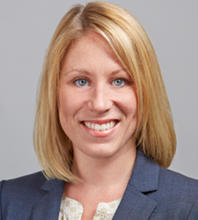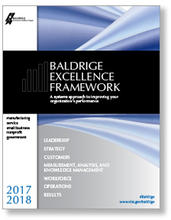Blogrige
The Official Baldrige Blog

Judges Panel Blog Series
In this judges panel blog series, we have been interviewing members of the Judges’ Panel of the Malcolm Baldrige National Quality Award to share individual members’ insights and perspectives on the award process, their experiences, and the Baldrige framework and approach to organizational improvement in general.
The primary role of the Judges’ Panel is to ensure the integrity of the Baldrige Award selection process. Based on a review of results of examiners’ scoring of written applications (the Independent and Consensus Review processes), judges vote on which applicants merit Site Visit Review (the third and final examination stage) to verify and clarify their performance in all seven Criteria categories of the Baldrige Excellence Framework. The judges also review reports from site visit to recommend to the U.S. Secretary of Commerce which organizations to name as U.S. role models—Baldrige Award recipients. No judge participates in any discussion of an organization for which he/she has a real or perceived conflict of interest. Judges serve for a period of three years.
Meet Baldrige Judge Allison Carter
Carter is one of five new Baldrige judges this year.

Allison A. Carter
Director
Guidehouse (formerly PricewaterhouseCoopers Public Sector LLP)
What experiences led you to the role of Baldrige judge?
I had zero experience with Baldrige when I was asked to lead [PricewaterhouseCooper Public Sector’s] efforts in February 2012. It was the very definition of building the plane while flying it—I was learning about the [Baldrige] framework, studying our previous Baldrige Award applications, and gaining an understanding of the organizational improvements we had implemented based on previous Baldrige feedback, all while leading development of our application, which was due about three months after I took over.
Luckily, I had a great team around me and strong leadership dedication, which were critical to our efforts! Through that experience, I learned a lot about the framework and realized how much it had helped us and could continue to drive operational improvements and results. I also identified a number of best practices, processes, and systems that were already closely aligned to the framework. For example, our coaching and mentoring programs, workforce development process, training, and succession planning were fully deployed, integrated, and producing impressive results!
After we became a Baldrige Award recipient in 2014, I began interacting with more organizations at various stages of their Baldrige journeys. I enjoyed the opportunity to share my own experience and provide insights that might help them improve. At Guidehouse, our mission is to help organizations improve operational effectiveness. When I was asked to become a member of the panel of judges for the Baldrige Award, it seemed right in line with that mission and also presented an opportunity to help other organizations on a broader scale.
How do you see the Baldrige Excellence Framework as valuable to organizations in your sector/industry?
One of the things my organization has seen quite frequently with our clients—and even within our own organization when we began our [Baldrige improvement] journey—is a lack of alignment between strategy and operations, as well as limited integration of organizational functions. That is, organizations are getting work done in individual departments, but employees may not understand how their day-to-day work supports the overall organizational strategy. Additionally, departments often don’t do a good job sharing information (successes and challenges), making data-driven decisions, and operating as a cohesive system. The Baldrige framework is extremely valuable to organizations in any industry to help them examine how their organization is working as a complete unit and how to align processes and measures in order to more effectively manage success.
At Guidehouse, we have had some of the same challenges—particularly with systematically consolidating data from different organizational units and using it to inform decision making. Implementing the Baldrige framework has been a key factor in helping us improve, resulting in phenomenal growth—24 percent in FY [fiscal year] 2017 alone. Other Baldrige Award recipients (regardless of industry) have achieved similar successes.
As a judge, what are your hopes for the judging process? For instance, is there anything you’d like to help applicants and potential Baldrige Award applicants understand about the process?
My hope as a first-year judge, first and foremost, is to survive the judging process! I’m looking forward to experiencing how things work on the “other side.” I also hope to help identify opportunities for improvement in the application, examination, and judging processes that could streamline and add transparency to the process to encourage more organizations to utilize the framework. Finally, I also hope to identify innovations and best practices from applicants that can be shared to help other organizations improve.
Judges Panel Blog Series: Upcoming Blogs
Dr. Kristin Stehouwer (Chair)
Bruce Requa
Previous Blogs
Glenn Crotty
Tammy L. Dye
Eric K. Fletcher
MG John C. Harris
Kevin R. McManu
John R. Molenda, Jr.
Dee Springer
A Systems Approach to Improving Your Organization’s Performance

Baldrige Excellence Framework
The Baldrige Excellence Framework has empowered organizations to accomplish their missions, improve results, and become more competitive. It includes the Criteria for Performance Excellence, core values and concepts, and guidelines for evaluating your processes and results.
Purchase your copy today!
Available versions: Business/Nonprofit, Education, and Health Care





